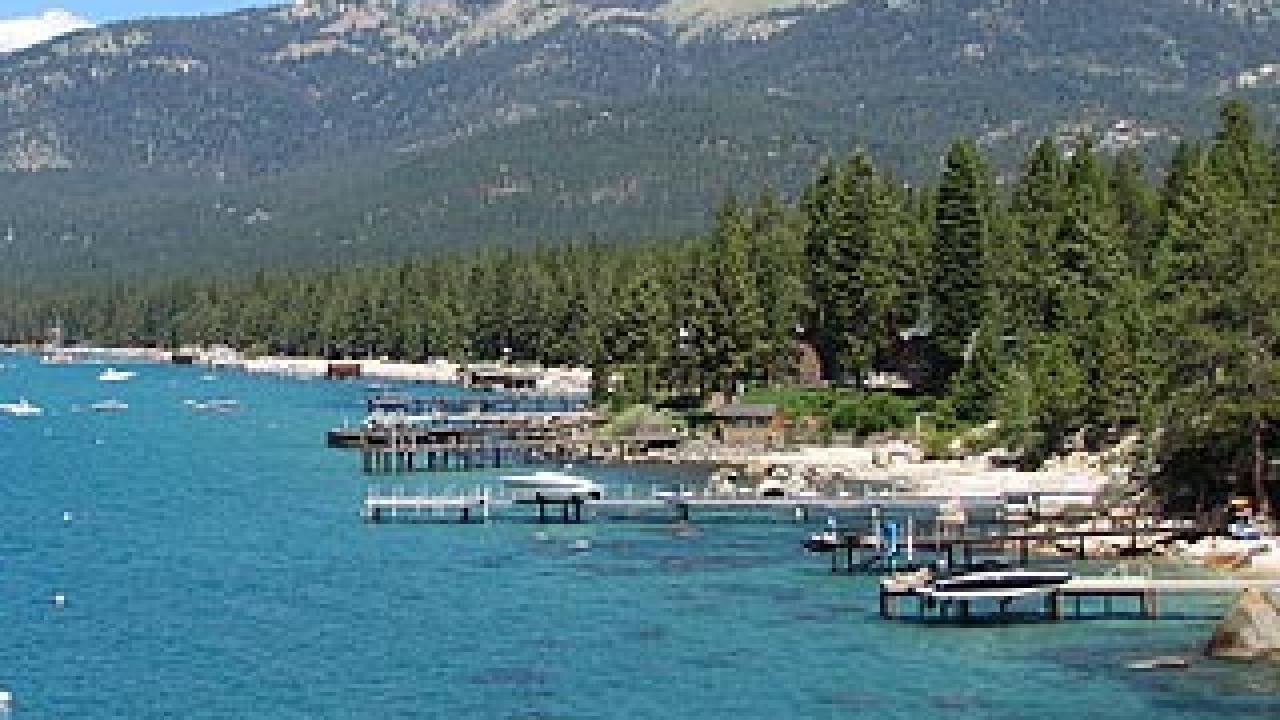Scientists today presented research findings and recommendations to the Tahoe Regional Planning Agency Governing Board that address Lake Tahoe’s aquatic nearshore environment and the heightened interest in understanding factors contributing to its apparent deterioration.
The Lake Tahoe Nearshore Evaluation and Monitoring Framework, a project funded during Round 10 of the Southern Nevada Public Land Management Act in 2010, was prepared for the USDA Forest Service by more than a dozen scientists and technical advisers from the Desert Research Institute, the University of Nevada, Reno, and the University of California, Davis.
In addition, a Nearshore Agency Working Group compiled of key staff from the California Regional Water Quality Control Board, Lahontan Region (Lahontan Water Board), the Nevada Division of Environmental Protection, the Tahoe Regional Planning Agency, and the U.S. Environmental Protection Agency participated throughout the process, communicating agency needs and supporting the scientists with relevant information.
“This represents the initial collaborative step between the science community and the resource management agencies to develop a comprehensive approach for assessing and managing the nearshore ecology and aesthetics of Lake Tahoe,” said Alan Heyvaert, principal investigator on the multiyear project and acting senior director of the Center for Watersheds and Environmental Sustainability at DRI.
The report does not recommend changes to existing state and TRPA legal or statutory definitions or standards affecting the Lake Tahoe nearshore. Rather, for the first time in one report, it:
- explains the unique aspects of this important zone;
- evaluates existing California, Nevada and TRPA standards and thresholds related to this region;
- presents a new conceptual model for evaluating nearshore environmental health;
- proposes a monitoring strategy intended to help resource managers identify the most meaningful physical, chemical and biological indicators of healthy nearshore conditions.
Heyvaert said that, for monitoring and assessment purposes, the report defines “nearshore” as the zone from the low water elevation (6,223 feet), or the current shoreline, to the mid-summer thermocline, which has a depth of approximately 69 feet, and at minimum a distance of 350 feet from shore.
"It is in the nearshore region that most people experience the lake,” said report co-author Geoffrey Schladow, director of the UC Davis Tahoe Environmental Research Center. “This report is an important step, as it establishes the scientific underpinnings of a successful nearshore restoration program."
Results from the report’s widespread literature review and data summary indicate that conditions can differ widely around the lake’s nearshore and create more localized effects as compared to the open waters of Lake Tahoe, which tend to be more uniform.
The report also emphasizes that pollutants entering the lake from watershed or groundwater can be temporarily concentrated in the nearshore before eventually being mixed and diluted in the open water, resulting in biological responses not observed or recorded in Lake Tahoe’s deep water.
“The nearshore environment is inherently complex since it is immediately adjacent to stormwater flow and runoff from the developed and undeveloped portions of the surrounding watershed,” said co-author John Reuter, research ecologist and associate director of the UC Davis Tahoe Environmental Research Center. “Therefore, it is recommended that a finer scale of evaluation and monitoring is necessary in this zone, especially for the nuisance blooms of attached algae found on rocks and other hard surfaces in the nearshore.”
Reuter added that in addition to pollutant factors, there are numerous other aspects unique to the nearshore environment that can contribute to variation in conditions, such as greater vulnerability to increased temperature from climate change, effects of nearshore recreation, existing and future shorezone structures, and fluctuation in lake levels.
The report also summarizes the proposed and targeted research needs related to monitoring and managing the nearshore.
“The introduction of aquatic invasive species has already produced some profound changes in the nearshore,” said co-author Sudeep Chandra, limnologist and director of UNR's Aquatic Ecosystems Analysis Laboratory. “Further establishment of aquatic invasive species in the nearshore has the potential to unravel the tremendous progress made toward protecting Lake Tahoe’s clarity.”
Chandra added that very little data exist on the nearshore community structure.
“We do not know the composition, distribution or abundance of most macro-organisms that inhabit the nearshore,” he said. “Base data are urgently needed to describe these conditions before they change any further.”
The findings and recommendations of the report are expected to support several agency statutory and programmatic needs by:
- providing baseline information that could assist in developing data collection and analysis needed to inform any revisions or assessments of relevant state and TRPA standards;
- supporting the development of products for the Tahoe Monitoring and Evaluation Program;
- tracking the effectiveness of the Tahoe Total Maximum Daily Load Program and other Environmental Improvement Program efforts related to nearshore conditions and contributing to detection and management of aquatic invasive species in the nearshore.
The full report is available at http://www.dri.edu/cwes.
About the Desert Research Institute
DRI, the nonprofit research campus of the Nevada System of Higher Education, strives to be the world leader in environmental sciences through the application of knowledge and technologies to improve people’s lives throughout Nevada and the world.
About the University of Nevada, Reno
Founded in 1874 as Nevada’s land-grant university, the University of Nevada, Reno ranks in the top tier of best national universities. With more than 18,000 students, the University is driven to contribute a culture of student success, world-improving research and outreach that enhances communities and business. Part of the Nevada System of Higher Education, the University has the system’s largest research program and is home to the state’s medical school. With outreach and education programs in all Nevada counties and home to one of the largest study-abroad consortiums, the University extends across the state and around the world.
Media Resources
Kat Kerlin, Research news (emphasis on environmental sciences), 530-750-9195, kekerlin@ucdavis.edu
John Reuter, UC Davis Tahoe Environmental Research Center, (530) 304-1473, jereuter@ucdavis.edu
Justin Broglio, Desert Research Institute, (775) 673-7610, Justin.broglio@dri.edu
Mike Wolterbeek, University of Nevada, Reno, (775) 784-4547, mwolterbeek@unr.edu
